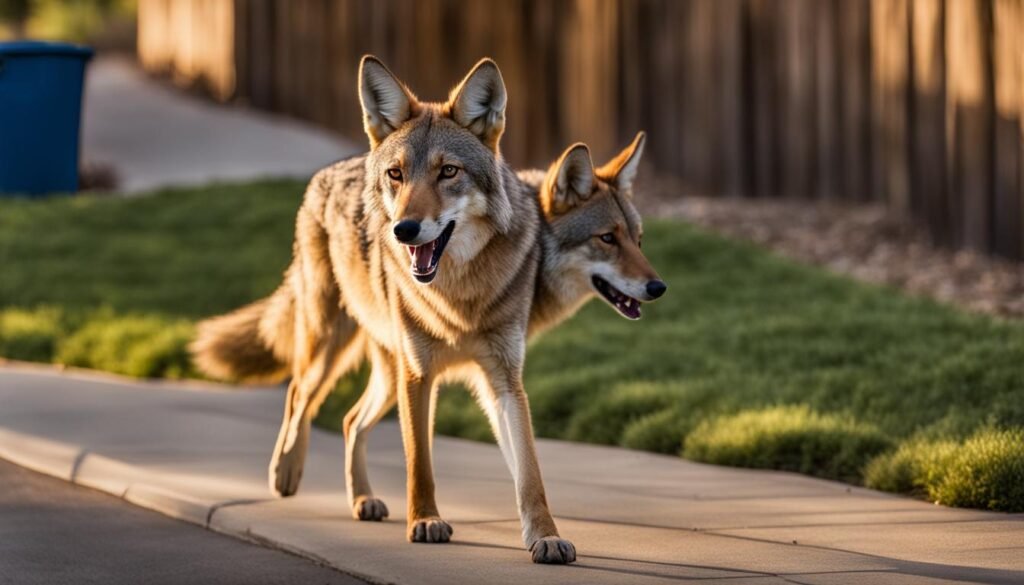As a nature enthusiast, I’ve always been fascinated by the remarkable adaptability of coyotes. These wily creatures have managed to thrive in diverse habitats across North America. Today, I want to explore the behavior of coyotes, their ecological role, and provide essential safety tips to ensure a harmonious coexistence between humans and these adaptable predators.
Coyotes, scientifically known as Canis latrans, are highly skilled survivors. With their keen intelligence and versatile nature, they have managed to colonize a wide range of environments, from forests and deserts to urban areas. Coyotes’ adaptability is truly remarkable, and understanding their behavior is crucial to mitigate potential conflicts and ensure the safety of both humans and coyotes.
These fascinating creatures lead daily lives similar to ours. They engage in activities such as finding food, playing, raising young, and avoiding threats. While most coyotes are shy and elusive, it is not uncommon to encounter bolder individuals who display curiosity or even approach humans. This behavior is often driven by their territorial instinct and an innate sense of curiosity.
To ensure safety, especially when walking with small dogs or children, it is important to maintain a safe distance from coyotes. Understanding their vocalizations and body language can help identify their intentions. If you encounter a coyote, make yourself appear larger, make loud noises, and slowly back away to discourage any potential interactions.
Key Takeaways:
- Coyotes are adaptable predators that play a vital ecological role.
- Understanding coyote behavior can help mitigate conflicts between humans, dogs, and coyotes.
- Maintain a safe distance from coyotes, particularly when walking with small dogs or children.
- Identify coyote vocalizations and body language to respond appropriately.
- Make yourself appear larger, make loud noises, and slowly back away to discourage interactions with coyotes.
Coyote-Human Interactions
Coyotes are fascinating creatures that generally have little interest in humans. However, there are instances where their curiosity may lead to unexpected encounters. Understanding how human interactions can influence coyote behavior is crucial to ensure the safety of both humans and coyotes in areas where they coexist.
When encountering coyotes, it is important to maintain a safe distance, especially if you are accompanied by small dogs or children. Coyotes have adapted to urban environments and may show brazen behavior if they become accustomed to humans providing food or other resources. By keeping a safe distance, we can minimize potential conflicts and allow coyotes to maintain their natural fear of humans.
One aspect of coyote behavior that can help us understand their intentions is vocalization. Coyotes communicate through a range of vocalizations, including howls, barks, yips, and yelps. These vocalizations serve different purposes, such as marking territory, warning other coyotes, or expressing distress. Understanding coyote vocalizations can help us identify their intentions and respond appropriately.
Additionally, coyotes have remarkable adaptations that allow them to thrive in various environments. Their keen senses, agility, and ability to camouflage themselves make them effective hunters and scavengers. Coyotes are also known for their intelligence and resourcefulness, which allows them to exploit opportunities in human-dominated landscapes. Recognizing these adaptations can help us appreciate the resilience of coyotes and their ability to coexist alongside humans.
Coyote Removal and Population Control
When it comes to dealing with coyotes, it’s important to understand that trapping, relocating, or killing them is not only inhumane but also ineffective. The use of traps and snares to capture coyotes can result in severe injuries to unintended targets, including pets and non-target wild animals. This method of coyote removal is not only cruel but also poses a risk to innocent creatures.
Furthermore, coyote removal efforts often prove to be challenging and costly, with no guarantee of capturing the specific coyote causing problems. Coyotes are intelligent and resilient animals, capable of bouncing back quickly even if a few individuals are removed from the population. This means that killing coyotes does not lead to a decrease in their overall population.
Instead of resorting to these inhumane methods, it is far more effective to focus on preventive measures and coexistence strategies. By understanding coyote behavior and taking the necessary precautions, we can minimize human-coyote conflicts and ensure the safety of both humans and coyotes.

Preventive measures to control coyote populations:
- Remove attractants: Secure garbage cans, keep them odor-free, and avoid leaving pet food outside.
- Secure fencing: Install fences around properties to prevent coyotes from entering residential areas.
- Implement hazing techniques: Make loud noises, use whistles or air horns, and throw objects to discourage coyotes from approaching.
- Responsible pet ownership: Keep dogs on leashes when in coyote-prone areas, supervise them outdoors, and keep cats indoors.
Remember: It is crucial to approach coyote management with compassion and consideration for both wildlife and domestic animals. By employing humane and effective preventive measures, we can achieve a harmonious coexistence with coyotes while ensuring the safety of all.
Coyotes and Pets
When it comes to coyotes and pets, it’s important to be aware of the potential risks and take necessary precautions. Coyotes may occasionally view small, unattended pets as prey, and larger dogs can be perceived as threats. Therefore, responsible pet ownership plays a crucial role in keeping our furry friends safe.
Cats, in particular, face numerous dangers when allowed to roam outdoors. They are at risk of encountering cars, diseases, and even coyotes. To protect your feline companions, it’s best to keep them indoors where they are safe from these potential dangers.
Feeding feral cats can inadvertently attract coyotes to your area, posing risks to both the cats and the coyotes themselves. Therefore, it’s important to refrain from leaving food outside, especially in regions where coyotes are known to roam.
When it comes to dogs, keeping them on leashes and supervising them outside is essential. This not only protects your dog from potential encounters with coyotes but also helps minimize any disturbances or conflicts between dogs and wildlife.
Coyote Safety Tips
To coexist with coyotes safely, it is essential to take proactive measures to prevent coyote attacks and ensure the safety of yourself, your family, and your pets. By following these coyote safety tips, you can minimize the risk of encounters:
1. Remove Attractants
Coyotes are often drawn to areas where they can find easily accessible food sources. To discourage coyotes from venturing into your property, make sure to:
- Securely store garbage in animal-proof containers.
- Keep fallen fruit picked up from the ground.
- Avoid leaving pet food outside unattended.
2. Implement Hazing Techniques
Hazing techniques can be effective in deterring coyotes from approaching humans. When encountering a coyote, try the following:
- Make loud noises by clapping your hands, blowing a whistle, or banging pots and pans together.
- Throw objects in the direction of the coyote, such as small stones or sticks, to create a sense of threat and intimidation.
3. Install Fencing
Installing sturdy fencing around your property can help keep coyotes out and create a physical barrier between them and your pets or small children. Make sure to choose fencing materials that are at least six feet tall and extend at least one foot below ground level to prevent coyotes from digging underneath.
4. Use Motion Sensor Lights and Sprinklers
Motion sensor lights and sprinklers can startle and discourage coyotes from entering your property. By triggering these devices when a coyote approaches, you can create an environment that is less appealing to them.
5. Never Attempt to Tame a Coyote
It is important to remember that coyotes are wild animals and should never be approached or tamed. Encouraging coyotes to become comfortable around humans can lead to increased risks and potential conflicts.
6. Keep Yourself Between the Coyote and Small Children
If you spot a coyote while walking with small children, ensure that you position yourself between the coyote and the children. This provides an extra layer of protection and minimizes the chances of an aggressive encounter.
By following these coyote safety tips and taking necessary precautions, you can reduce the potential for coyote attacks and foster a safe coexistence with these fascinating creatures.

Coyote Repellents and Deterrents
While removing food sources and implementing hazing techniques are the most effective long-term solutions to prevent coyote attacks and remove them from your property, there are additional methods you can use as repellents and deterrents to provide temporary relief.
One effective option is to install solar-powered, motion sensor lights around your property. These lights not only act as a deterrent by illuminating the area but also help create a sense of security. Additionally, they can startle and discourage coyotes from approaching.
Another effective method is using sounds to deter coyotes. Use devices that emit loud, high-pitched noises or prerecorded sounds of larger predators to make coyotes wary. These sounds mimic the presence of a threat, making the area less desirable for coyotes to approach.
Furthermore, sprinklers equipped with motion sensors can be effective at deterring coyotes. Set them up strategically around your property, and when the sensor detects movement, it will activate the sprinklers, startling the coyotes and discouraging them from coming closer.
If you prefer a more natural approach, you can use bitter or spicy taste deterrents as coyote repellents. Apply these deterrents to areas that coyotes may target, such as fences, trash cans, or garden plants. The unpleasant taste will discourage coyotes from returning to those areas.
It’s important to note that while these repellents and deterrents can be effective in certain situations, they should be used as part of a comprehensive approach that includes removing food sources, implementing hazing techniques, and other preventive measures. Using these methods in combination will significantly increase your chances of preventing coyote attacks and successfully deterring them from your property.
Summary:
- Install solar-powered, motion sensor lights as a deterrent.
- Use devices that emit loud, high-pitched noises or prerecorded sounds of larger predators to make the area less desirable for coyotes.
- Set up sprinklers equipped with motion sensors to startle and discourage coyotes from approaching.
- Apply bitter or spicy taste deterrents to areas coyotes may target.
- Combine these repellents and deterrents with other preventive measures for maximum effectiveness.
Coyote Disease Risks
Coyotes, like any warm-blooded mammal, have the potential to contract rabies. However, instances of coyotes with rabies have been rare in recent years. It is crucial to avoid approaching or handling wild animals and to vaccinate pets against rabies.
Coyotes with mange can appear threatening due to their weakened condition and strange appearance but are not more likely to attack humans or pets. Protecting poultry and outdoor animals from predators, including coyotes, is important to ensure their safety.
Conclusion
To ensure a safe and harmonious coexistence with coyotes, it is vital to understand their behavior and take necessary precautions. By removing potential food sources, such as garbage and pet food left outside, we can reduce the attraction for coyotes and minimize human-coyote conflicts. Implementing hazing techniques, such as making loud noises or throwing objects, can deter coyotes from approaching humans and their surroundings.
Responsible pet ownership is also crucial in preventing negative interactions with coyotes. Keeping cats indoors and supervising dogs when outside can protect them from potential harm. Additionally, always keeping yourself between the coyote and small children can help ensure their safety.
Education and awareness play a significant role in promoting a harmonious relationship with wildlife. By sharing knowledge about coyote behavior, habitat, and safety measures, we can empower communities to make informed decisions and take the necessary steps to coexist peacefully with these adaptable predators. Together, we can create a balance between the needs of both humans and coyotes, fostering a respectful and sustainable environment.
FAQ
What are some common activities of coyotes?
Coyotes engage in activities such as finding food, playing, raising young, and avoiding threats, similar to humans.
How do coyotes behave towards humans?
While most coyotes are shy, some may display curiosity or bold behavior in certain situations. It is important to maintain a safe distance from coyotes, particularly if walking with small dogs or children.
Is it true that trapping or killing coyotes is effective for population control?
No, trapping, relocating, or killing coyotes is inhumane and ineffective. Coyotes are intelligent and resilient animals capable of bouncing back quickly.
Can coyotes pose a threat to pets?
Coyotes may view small, unattended pets as prey or perceive larger dogs as threats. It is crucial to keep cats indoors and practice responsible pet ownership by keeping dogs on leashes and supervising them outside.
What are some safety tips to prevent coyote attacks?
To coexist with coyotes safely, it is essential to remove food sources that may attract them, such as garbage and pet food. Implementing hazing techniques and installing fencing can also help deter them.
Are there any repellents or deterrents for coyotes?
Certain repellents and deterrents, such as motion sensor lights, sounds, sprinklers, and bitter or spicy taste deterrents, may provide temporary relief if used consistently.
Can coyotes carry diseases?
Coyotes, like any warm-blooded mammal, have the potential to contract rabies. However, instances of coyotes with rabies have been rare in recent years. It is crucial to avoid approaching or handling wild animals and to vaccinate pets against rabies.
What is the conclusion regarding coyote behavior and safety?
Understanding coyote behavior, practicing responsible pet ownership, removing food sources, and implementing deterrence techniques can help foster a relationship of coexistence and ensure the safety of both humans and coyotes.







